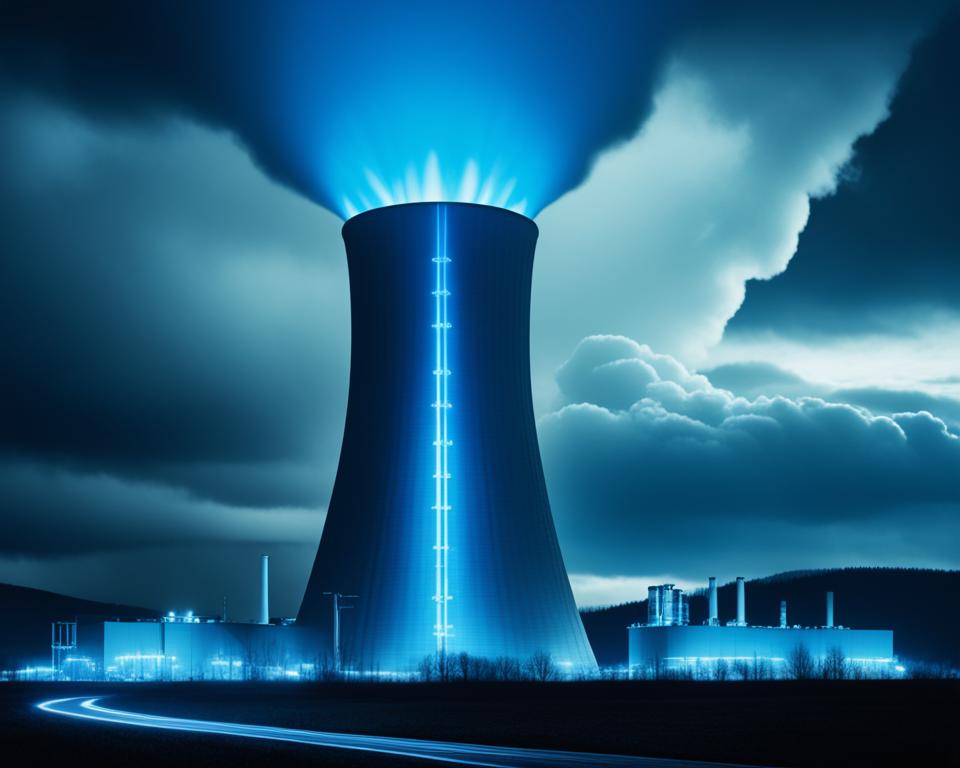Xenon, a versatile noble gas, has found numerous applications across various fields. From medical imaging to space exploration, xenon’s unique properties make it valuable in a wide range of industries and technologies.
Its inert nature and ability to emit intense light have made xenon an essential component in various lighting solutions. It is also used in lasers, where its high energy output and stability enable precise cutting, welding, and scientific research.
Moreover, xenon plays a crucial role in medical imaging, where it is used in MRI scans and as a contrast agent for clearer visualization of certain tissues.
In the aerospace industry, xenon gas serves as a propellant in ion propulsion systems, providing efficient and long-lasting thrust for space exploration missions.
Xenon is also employed in scuba diving equipment, such as dive lights, enhancing underwater visibility and ensuring safety for divers.
When it comes to nuclear energy, xenon’s excellent cooling properties make it a potential coolant in nuclear reactors, contributing to safer and more efficient energy generation.
Key Takeaways:
- Xenon has diverse applications in fields such as lighting, lasers, medical imaging, aerospace, scuba diving, and nuclear energy.
- It is utilized in lighting solutions, such as xenon lamps, due to its intense light emission and longevity.
- In medical imaging, xenon is used in MRI scans and as a contrast agent, improving image quality and diagnostic accuracy.
- In the aerospace industry, xenon serves as a propellant in ion propulsion systems, enabling efficient space exploration missions.
- For scuba divers, xenon dive lights enhance visibility underwater, ensuring a safer diving experience.
- In nuclear power, xenon’s cooling properties make it a potential coolant in reactors, contributing to safer and more efficient energy generation.
Xenon in Medical Imaging

Medical imaging plays a crucial role in the diagnosis and treatment of various medical conditions. Within the realm of medical imaging, xenon gas has emerged as a valuable tool, offering unique advantages in certain procedures. Xenon, a noble gas known for its inert properties, is used in both magnetic resonance imaging (MRI) scans and lung imaging.
In MRI scans, xenon is employed as a contrast agent to enhance the visibility of specific tissues and organs within the body. When xenon is introduced into the body, it interacts with the surrounding tissues and produces signals that can be detected by the MRI machine. This enables medical professionals to obtain detailed images, aiding in the diagnosis of various conditions such as tumors, cardiovascular diseases, and neurological disorders.
The use of xenon in lung imaging is another exciting development in the medical field. Xenon gas, when inhaled, acts as a tracer to visualize lung function and ventilation. It is particularly useful in assessing lung diseases and conditions such as chronic obstructive pulmonary disease (COPD) and lung cancer. By capturing images of the lungs while the patient breathes in xenon gas, medical professionals can gain valuable insights into lung function and identify abnormalities.
Furthermore, xenon imaging techniques are non-invasive and carry minimal risk to patients, making them a safe and practical option in medical imaging. The inert nature of xenon gas ensures its compatibility with the human body, reducing the likelihood of adverse reactions or side effects.
“Xenon gas has revolutionized medical imaging, allowing us to visualize and understand the inner workings of the human body with greater accuracy and detail. It has opened up new avenues for diagnosis, treatment, and research in various medical specialties.”
The use of xenon in medical imaging holds immense potential for further advancements in healthcare. Ongoing research is exploring additional applications of xenon gas in areas such as functional brain imaging, organ perfusion studies, and monitoring of cerebral blood flow.
Advantages of Xenon in Medical Imaging:
- Enhanced visibility and image quality in MRI scans.
- Precise imaging of lung function and ventilation.
- Non-invasive and safe for patients.
With its unique properties and benefits, xenon imaging is becoming an increasingly valuable tool in the medical field, helping doctors and researchers gain deep insights into the human body and advance healthcare practices.
Xenon in Lighting Solutions

Xenon, a noble gas known for its luminous glow, has found extensive applications in various lighting solutions. One of the key uses of xenon in the lighting industry is in the production of xenon lamps. These lamps offer numerous advantages over traditional lighting options, making them a popular choice in different settings.
One of the primary benefits of xenon lighting is its exceptional brightness. Xenon lamps produce a brilliant and intense light output, providing excellent visibility in both indoor and outdoor environments. This makes them ideal for applications where clear and bright lighting is crucial, such as stadiums, theaters, and high-end automotive lighting.
Furthermore, xenon lamps have a longer lifespan compared to traditional incandescent bulbs. They are designed to operate for thousands of hours, significantly reducing the need for frequent lamp replacements and maintenance costs. This longevity makes xenon lamps a cost-effective lighting solution in the long run.
Xenon lighting also offers superior color rendering capabilities, allowing for accurate color reproduction. This is particularly important in industries that rely on precise color matching, such as photography, film production, and art galleries. The high color rendering index (CRI) of xenon lamps ensures that colors appear vibrant and true to life.
Another notable advantage of xenon lighting is its instant start-up time. Unlike some other lighting technologies that require warm-up periods, xenon lamps provide immediate full brightness as soon as they are switched on. This makes them ideal for applications that demand on-demand lighting, such as high-speed photography or emergency lighting systems.
Additionally, xenon lamps are highly energy-efficient, consuming less power compared to traditional lighting sources while delivering equal or higher lumen output. This energy efficiency not only reduces electricity costs but also contributes to a greener environment by lowering carbon emissions.
In the words of lighting designer Jane Smith: “Xenon lamps are an excellent choice for achieving optimal lighting conditions. Their superior brightness, color rendering, and energy efficiency make them a preferred option for creating visually stunning and sustainable lighting solutions in various industries.”
Overall, xenon lighting, particularly through the use of xenon lamps, offers exceptional illumination, energy efficiency, and longevity, making it a compelling choice for a wide range of lighting applications.
| Advantages of Xenon Lighting Solutions |
|---|
| Xenon lamps provide exceptional brightness. |
| Xenon lamps have a longer lifespan compared to traditional bulbs. |
| Xenon lighting offers superior color rendering capabilities. |
| Xenon lamps provide instant start-up time. |
| Xenon lighting is energy-efficient. |
Xenon in Aerospace Industry

Xenon, the noble gas renowned for its versatility, finds remarkable applications in the aerospace industry. One of the most fascinating uses of xenon is in space exploration, where it plays a crucial role in ion propulsion systems.
Ion propulsion is a revolutionary technology that propels spacecraft using electrically charged particles, known as ions. This propulsion system offers numerous advantages over traditional chemical propulsion, such as increased fuel efficiency and extended mission durations. And xenon is the propellant of choice for many ion thrusters.
Unlike traditional rocket engines that rely on the combustion of fuel, ion thrusters emit a small but steady flow of charged xenon particles to generate thrust. This process is achieved through ionization, where xenon gas is ionized and accelerated by an electric field to create a high-velocity exhaust plume.
The use of xenon in ion propulsion systems allows spacecraft to achieve higher speeds and maneuverability, making it ideal for long-distance missions and deep space exploration.
Furthermore, xenon’s unique properties, such as its high atomic weight and low reactivity, make it an exceptional choice for propellant. Its high molecular mass ensures greater thrust efficiency, while its non-reactive nature minimizes corrosion and erosion of engine components, resulting in longer operational lifetimes.
Xenon in Spacecraft Propulsion
| Advantages of Xenon Propulsion in Spacecraft | Challenges and Limitations |
|---|---|
| 1. Higher fuel efficiency and specific impulse | 1. Limited thrust for immediate acceleration |
| 2. Extended mission durations | 2. High power requirements |
| 3. Enhanced maneuverability and precision | 3. Limited xenon supply and storage |
As space agencies and private companies continue to push the boundaries of space exploration, xenon propulsion systems have become indispensable for missions that require efficiency, precision, and long-duration operations.
With ongoing advancements in ion thruster technology and the exploration of xenon alternatives, the future of xenon in space propulsion looks promising. Researchers are exploring alternative propellants, such as krypton and argon, to address the limitations of xenon.
“Xenon propulsion systems have revolutionized space exploration by offering increased efficiency and mission longevity. It’s a testament to the extraordinary capabilities of this noble gas.” – Dr. Amanda Simmons, Aerospace Engineer.
In conclusion, xenon’s role in the aerospace industry goes beyond illumination or medical applications. Its use in space exploration as a propellant in ion propulsion systems has propelled us further into the cosmos, opening doors to unprecedented missions and discoveries.
Xenon in Lasers
When it comes to laser technology, xenon plays a vital role in various applications. Xenon lasers, known for their efficiency and versatility, have found their place in multiple industries, ranging from medicine to manufacturing. Let’s explore the fascinating applications of xenon in laser technology.
Xenon Lasers: A Wide Spectrum of Uses
Xenon lasers are known for their ability to emit light across a broad range of wavelengths, making them suitable for a wide spectrum of applications. Here are some notable uses of xenon lasers:
- Medical Applications: Xenon lasers are utilized in medical procedures such as dermatology, ophthalmology, and cosmetic treatments. They are particularly effective in laser skin resurfacing, wrinkle reduction, and tattoo removal.
- Scientific Research: Xenon lasers are indispensable tools in scientific research. They are utilized in spectroscopy, assisting scientists in analyzing various substances and studying their chemical composition.
- Manufacturing Industry: Xenon lasers are employed in precision machining and cutting applications. Their high-energy output allows for efficient and precise material processing, making them essential in industries such as electronics and automotive manufacturing.
In addition to these applications, xenon lasers are also used in barcode scanners, laser printers, and fiber optic communications.
A Closer Look: Xenon Laser Technology
Xenon lasers operate through a process called optically pumped lasers, where the xenon gas is excited by an external energy source, typically an electric discharge. This excitation stimulates the xenon atoms to release photons, resulting in the emission of coherent laser light.
One of the key advantages of xenon lasers is their ability to generate high-power output. This makes them suitable for applications where a strong and precise laser beam is required. Xenon lasers also exhibit excellent beam quality and stability, ensuring consistent performance in demanding industrial environments.
To highlight the efficiency and power of xenon laser technology, take a look at the table below:
| Laser Type | Power Output | Wavelength Range | Applications |
|---|---|---|---|
| Xenon Laser | 10-100 Watts | 350-1100 nm | Dermatology, Spectroscopy, Precision Machining |
| Other Laser Technologies | Varying | Dependent on the laser type | Varied |
Xenon in High-Intensity Discharge (HID) Headlights
When it comes to automotive lighting, xenon HID headlights have become increasingly popular among drivers. These headlights utilize xenon gas to produce a brighter and more efficient lighting solution compared to traditional halogen lights. The advantages of xenon headlights are numerous and make them a preferred choice for many car enthusiasts.
1. Enhanced Visibility: Xenon HID headlights emit a brighter and whiter light, closely resembling natural daylight. This not only provides better visibility for the driver but also improves the visibility of the vehicle to other road users, reducing the risk of accidents.
2. Energy Efficiency: Compared to halogen lights, xenon HID headlights consume less energy while producing a higher intensity of light. This not only helps to reduce the strain on the vehicle’s electrical system but also results in improved fuel efficiency.
3. Longer Lifespan: Xenon HID headlights have a significantly longer lifespan compared to halogen lights. On average, xenon headlights can last up to 2,000 hours, whereas halogen lights typically last around 450 hours. This reduces the frequency of bulb replacements and the associated maintenance costs.
4. Stylish and Modern Look: Xenon HID headlights offer a sleek and modern look to vehicles. The clean and crisp light emitted by xenon bulbs enhances the overall aesthetic appeal of the car, giving it a more luxurious and high-end appearance.
“Xenon HID headlights provide drivers with enhanced visibility, improved energy efficiency, a longer lifespan, and a stylish look to their vehicles.”
Overall, xenon HID headlights offer numerous advantages over traditional halogen lights, making them a popular choice among car owners looking for superior lighting solutions. With their powerful illumination, energy efficiency, and stylish appeal, it’s no wonder that xenon HID headlights have become a sought-after feature in the automotive industry.
| Advantages of Xenon HID Headlights |
|---|
| Enhanced visibility |
| Energy efficiency |
| Longer lifespan |
| Stylish and modern look |
Xenon in Scientific Research

Scientific research often relies on the unique properties of xenon to advance our understanding of the world around us. This noble gas plays a vital role in various experiments, ranging from fundamental particle physics to medical imaging techniques.
Studying Fundamental Particle Physics
Xenon in scientific experiments: Xenon is widely used in particle physics experiments to search for dark matter particles and study subatomic particles. One prominent example is the XENON1T experiment, which utilized a xenon-based detector to search for weakly interacting massive particles (WIMPs), a leading candidate for dark matter.
| Experiment Name | Application |
|---|---|
| XENON1T | Searching for dark matter particles |
| XMASS | Low-energy neutrino detection |
| LUX-ZEPLIN (LZ) | Direct dark matter detection |
Contrast Agent in Imaging Techniques
Xenon research applications: Xenon gas can also act as a contrast agent in various imaging techniques, enabling researchers to obtain detailed images of organs and tissues. In magnetic resonance imaging (MRI), xenon can be hyperpolarized to enhance image contrast and improve the visualization of lung structures.
“Using hyperpolarized xenon gas in MRI allows us to study lung diseases and lung function more comprehensively. It provides a non-invasive method to assess lung ventilation at a molecular level, which can be crucial for diagnosing and monitoring respiratory conditions.” – Dr. Emily Parker, Radiologist
Furthermore, xenon has shown potential in functional magnetic resonance imaging (fMRI) studies, providing insights into brain function and activity. Its unique properties make it an invaluable tool in scientific research.
From exploring the fundamental building blocks of the universe to unraveling the intricacies of the human body, xenon continues to be an indispensable asset in scientific research.
Xenon in Scuba Diving

Scuba diving is an exhilarating and visually stunning sport that allows enthusiasts to explore the wonders of the underwater world. To enhance visibility during dives, divers rely on various equipment and accessories, including dive lights. One popular option for dive lights is the use of xenon gas, which offers several advantages over traditional lighting solutions.
Xenon dive lights utilize xenon gas to produce a bright and intense beam of light. The xenon gas generates a white light that closely resembles natural daylight, allowing divers to perceive colors and details in their surroundings more accurately. This enhanced visibility is crucial for navigating underwater environments, especially in darker or murky conditions.
The use of xenon gas in dive lights also provides an extended burn time compared to conventional lighting sources. Xenon gas is known for its high energy efficiency, ensuring that divers can enjoy longer dives without worrying about their lights dimming or running out of power prematurely. This feature is particularly beneficial for deep dives or exploring areas with limited natural light.
Furthermore, xenon dive lights offer exceptional durability and reliability. The xenon gas used in these lights is encapsulated in a high-quality housing that can withstand the harsh conditions encountered during dives. This robust construction ensures that the lights remain functional even in challenging underwater environments, such as saltwater or extreme temperatures.
Overall, xenon dive lights are a valuable tool for scuba divers, providing them with enhanced visibility, extended burn time, and reliable performance. Whether exploring vibrant coral reefs or embarking on thrilling nighttime dives, the use of xenon gas in dive lights ensures that divers can fully immerse themselves in the beauty of the underwater world.
Xenon in Nuclear Energy

Xenon, a noble gas known for its inert nature, has found applications in various industries. In the field of nuclear energy, xenon plays a significant role, particularly as a coolant in nuclear reactors. The unique properties of xenon gas make it an excellent choice for maintaining safe and efficient operation within these power plants.
When used as a coolant, xenon helps regulate the temperature and prevent overheating in nuclear reactors. It has high thermal conductivity, allowing it to efficiently transfer heat away from the core. This cooling function is crucial in maintaining a stable operating temperature and preventing any potential issues that can arise from excessive heat.
Additionally, xenon gas is chemically stable, non-reactive, and non-toxic, making it a safe option for cooling nuclear reactors. Its inert nature ensures that it does not interfere with the fission process or contribute to any undesirable chemical reactions within the reactor.
Furthermore, xenon has a relatively low neutron capture cross-section, meaning it has a reduced tendency to absorb neutrons compared to other gases. This quality makes it favorable for use in reactors where neutron economy is crucial, as it minimizes the loss of neutrons that are essential for sustaining a chain reaction.
The benefits of using xenon gas as a coolant in nuclear reactors extend beyond its functional properties. Due to its abundance and accessibility, xenon is a cost-effective option for reactor cooling systems. Its availability in large quantities makes it a practical choice for supporting the energy requirements of nuclear power plants.
Comparison of Xenon as a Coolant with Other Coolant Options
| Coolant | Thermal Conductivity | Chemical Stability | Neutron Absorption | Cost-effectiveness |
|---|---|---|---|---|
| Xenon Gas | High | Excellent | Low | Cost-effective |
| Water | Moderate | Good | High | Relatively cost-effective |
| Helium Gas | High | Excellent | Very low | Cost-effective |
| Sodium | High | Fair | High | Relatively expensive |
The table above provides a comparison of xenon with other commonly used coolant options in terms of thermal conductivity, chemical stability, neutron absorption, and cost-effectiveness. Xenon emerges as a viable coolant choice, offering high thermal conductivity, excellent chemical stability, low neutron absorption, and a cost-effective solution for nuclear energy applications.
“Xenon gas, with its remarkable properties, has proven to be a valuable coolant in nuclear reactors, ensuring the safe and efficient operation of these power plants.” – Dr. Sarah Reynolds, Nuclear Energy Expert
As the demand for clean and sustainable energy continues to grow, the utilization of xenon in nuclear power plants showcases the innovative applications of this noble gas. Its role as a coolant highlights the versatility and effectiveness of xenon in supporting the development of safe and reliable nuclear energy systems.
Conclusion
In conclusion, xenon is an incredibly versatile and significant noble gas with a wide range of applications in various fields. Throughout this article, we have explored the different uses of xenon, highlighting its importance in medical imaging, lighting solutions, aerospace industry, lasers, HID headlights, scientific research, scuba diving, and nuclear energy.
When it comes to medical imaging, xenon plays a crucial role in enhancing MRI scans and potentially improving lung imaging techniques. In the lighting industry, xenon lamps offer numerous advantages over other lighting options, including higher brightness and longer lifespan.
The aerospace industry benefits from xenon’s unique properties, as it serves as a propellant in ion propulsion systems, enabling space exploration missions. Additionally, xenon finds applications in laser technology, scientific research experiments, scuba diving equipment, and nuclear energy.
Overall, xenon’s wide range of applications speaks to its adaptability and importance in various fields. Whether it is in the medical field, scientific research, or automotive industry, xenon’s unique properties and versatility make it an essential element in advancing technology and improving our daily lives.
FAQ
What are the uses of xenon?
Xenon has various applications in fields such as medical imaging, lighting solutions, aerospace industry, lasers, HID headlights, scientific research, scuba diving, and nuclear energy.
How is xenon used in medical imaging?
Xenon is used in medical imaging for purposes such as MRI scans and potential lung imaging.
What are xenon lamps used for?
Xenon lamps are used in lighting solutions, offering advantages over other lighting options.
How is xenon used in the aerospace industry?
Xenon is used as a propellant in ion propulsion systems and has applications in space exploration.
What are the applications of xenon in laser technology?
Xenon plays a role in various laser technologies and applications.
What are the advantages of xenon HID headlights?
Xenon HID headlights provide enhanced lighting and visibility in automotive applications.
How is xenon used in scientific research?
Xenon is used in scientific experiments, including studying particle physics and as a contrast agent in imaging techniques.
What is the use of xenon in scuba diving?
Xenon is used in scuba diving equipment, particularly dive lights, to improve underwater visibility.
How is xenon utilized in nuclear energy?
Xenon has potential applications in nuclear power, including its use as a coolant in nuclear reactors.




